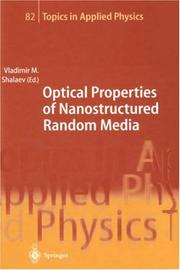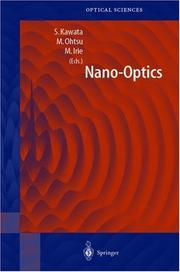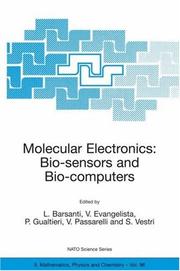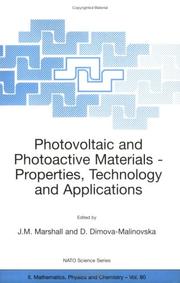| Listing 1 - 10 of 17 | << page >> |
Sort by
|

ISBN: 3540420312 9783540420316 Year: 2002 Publisher: Berlin: Springer,
Abstract | Keywords | Export | Availability | Bookmark
 Loading...
Loading...Choose an application
- Reference Manager
- EndNote
- RefWorks (Direct export to RefWorks)
Nanostructured materials. --- Nonlinear optics. --- Acqui 2006 --- Nanostructured materials --- Nonlinear optics

ISBN: 3540431233 9622018610 9783540431237 Year: 2002 Volume: 8 Publisher: New York (N.Y.): Springer,
Abstract | Keywords | Export | Availability | Bookmark
 Loading...
Loading...Choose an application
- Reference Manager
- EndNote
- RefWorks (Direct export to RefWorks)
Photonics --- Nonlinear optics --- Photonique --- Optique non linéaire --- Optique non linéaire
Book
ISBN: 2868835287 2271059542 9782868835284 9782271059543 Year: 2002 Publisher: Les Ulis: EDP sciences,
Abstract | Keywords | Export | Availability | Bookmark
 Loading...
Loading...Choose an application
- Reference Manager
- EndNote
- RefWorks (Direct export to RefWorks)
Lasers --- Optique non linéaire --- Lumière --- Diffusion --- Nonlinear optics --- Light --- Scattering --- Lasers.

ISBN: 9812381635 9812381643 9789812381644 9789812381637 Year: 2002 Publisher: River Edge, NJ: World scientific,
Abstract | Keywords | Export | Availability | Bookmark
 Loading...
Loading...Choose an application
- Reference Manager
- EndNote
- RefWorks (Direct export to RefWorks)
Quantum field theory --- Quantum optics --- Nonlinear optics --- Mathematical physics --- Physique mathématique --- Mathematical models --- Physique mathématique --- Quantum field theory - Mathematical models --- Quantum optics - Mathematical models --- Nonlinear optics - Mathematical models
Book
ISBN: 2759802779 1417561386 9781417561384 9782759802777 Year: 2002 Publisher: Les Ulis Paris EDP Sciences CNRS Editions
Abstract | Keywords | Export | Availability | Bookmark
 Loading...
Loading...Choose an application
- Reference Manager
- EndNote
- RefWorks (Direct export to RefWorks)
To help students and scientists, who would like to understand how lasers work and/or who need lasers to improve their work performance, this title covers the following:. - Einstein's formula for probability;. - The description of Gaussian clusters and radiation modes;. - The approach of quantum interaction between the atom and the radial electric field.
Lasers. --- Light amplification by stimulated emission of radiation --- Masers, Optical --- Optical masers --- Light amplifiers --- Light sources --- Optoelectronic devices --- Nonlinear optics --- Optical parametric oscillators
Book
ISBN: 9786610470853 1282367323 1280470852 0198028636 9786612367328 1602567026 9780198028635 0199882428 0197732321 Year: 2002 Publisher: New York Oxford Oxford University Press
Abstract | Keywords | Export | Availability | Bookmark
 Loading...
Loading...Choose an application
- Reference Manager
- EndNote
- RefWorks (Direct export to RefWorks)
Charles Townes invented the maser and the laser, and was a pioneer in the use of spectroscopic techniques to determine the atomic composition of stars. This is the memoir of a life devoted to scientific research.
Lasers --- Masers --- Science and state --- Microwave amplification by stimulated emission of radiation --- Quantum mechanical amplifiers --- Electromagnetism --- Electron tubes --- Infrared sources --- Microwave amplifiers --- Microwave devices --- Optical pumping --- Quantum electronics --- Light amplification by stimulated emission of radiation --- Masers, Optical --- Optical masers --- Light amplifiers --- Light sources --- Optoelectronic devices --- Nonlinear optics --- Optical parametric oscillators --- History.

ISBN: 3540418296 3642075274 3540452737 9783540418290 Year: 2002 Volume: 84 Publisher: Berlin: Springer,
Abstract | Keywords | Export | Availability | Bookmark
 Loading...
Loading...Choose an application
- Reference Manager
- EndNote
- RefWorks (Direct export to RefWorks)
When a photon meets a nanostructure, many interesting phenomena occur. This book aims at developing the theories and the applications of photon interactions with nanostructures. The contributors were all participants in the well-known Japanese national research project, "Near-Field Nano-Optics", which ran from 1997 to 2000. The book covers a wide range of disciplines in nano-optics, including the theoretical development of imaging-contrast mechanisms as a result of photon and nanomatter interactions, and discussions on different near-field nanoprobes. Applications of nano-optics to sensing, imaging, analysis, and the fabrication of nanostructures, such as molecules and quantum devices, are also discussed, with a collection of experimental examples.
Nanostructured materials --- Near-field microscopy --- Quantum optics --- Photonics --- Nanomatériaux --- Microscopie en champ proche --- Optique quantique --- Photonique --- Nanostructured materials. --- Near-field microscopy. --- Quantum optics. --- Photonics. --- Nanomatériaux --- Lasers. --- Materials—Surfaces. --- Thin films. --- Materials science. --- Nanotechnology. --- Optics, Lasers, Photonics, Optical Devices. --- Surfaces and Interfaces, Thin Films. --- Characterization and Evaluation of Materials. --- Molecular technology --- Nanoscale technology --- High technology --- Material science --- Physical sciences --- Films, Thin --- Solid film --- Solid state electronics --- Solids --- Surfaces (Technology) --- Coatings --- Thick films --- New optics --- Optics --- Light amplification by stimulated emission of radiation --- Masers, Optical --- Optical masers --- Light amplifiers --- Light sources --- Optoelectronic devices --- Nonlinear optics --- Optical parametric oscillators


ISBN: 140201211X 1402012128 9401001413 Year: 2002 Volume: v. 96 Publisher: Dordrecht ; Boston ; London Brussels Kluwer Academic Publishers NATO Scientific Affairs Division
Abstract | Keywords | Export | Availability | Bookmark
 Loading...
Loading...Choose an application
- Reference Manager
- EndNote
- RefWorks (Direct export to RefWorks)
How fast and powerful can computers become? Will it be possible someday to create artificial brains that have intellectual capabilities comparable to those of human beings? The answers to these questions depend to a very great extent on a single factor: how small and dense we can make computer circuits. Very recently, scientists have achieved revolutionary advances that may very well radically change the future of computing. There are significant advantages to using biological molecules in a new computational paradigm, since nature has solved similar problems to those encountered in harnessing organic molecules to perform data manipulation. Biomolecules could be used as photonic devices in holography, as spatial light modulators, in neural network optical computing, as nonlinear optical devices, and as optical memories. Such computers may use a billion times less energy than electronic computers, while storing data in a trillionth of the space, while also being highly parallel. Research projects implemented by national and international groups have produced a large amount of data from multidisciplinary work, ranging from physics and engineering to chemistry and biology.
Molecular electronics --- Biosensors --- Biomolecules --- Electronique moléculaire --- Biocapteurs --- Biomolécules --- Congresses. --- Congrès --- Biochemistry. --- Physical chemistry. --- Lasers. --- Photonics. --- Materials science. --- Chemical engineering. --- Biochemistry, general. --- Physical Chemistry. --- Optics, Lasers, Photonics, Optical Devices. --- Characterization and Evaluation of Materials. --- Industrial Chemistry/Chemical Engineering. --- Chemistry, Industrial --- Engineering, Chemical --- Industrial chemistry --- Engineering --- Chemistry, Technical --- Metallurgy --- Material science --- Physical sciences --- New optics --- Optics --- Light amplification by stimulated emission of radiation --- Masers, Optical --- Optical masers --- Light amplifiers --- Light sources --- Optoelectronic devices --- Nonlinear optics --- Optical parametric oscillators --- Chemistry, Theoretical --- Physical chemistry --- Theoretical chemistry --- Chemistry --- Biological chemistry --- Chemical composition of organisms --- Organisms --- Physiological chemistry --- Biology --- Medical sciences --- Composition

ISBN: 0849308267 9780849308260 Year: 2002 Publisher: Boca Raton: CRC,
Abstract | Keywords | Export | Availability | Bookmark
 Loading...
Loading...Choose an application
- Reference Manager
- EndNote
- RefWorks (Direct export to RefWorks)
Artificial intelligence. Robotics. Simulation. Graphics --- Materials sciences --- Electronics --- Microelectronics --- Integrated circuits --- Microelectromechanical systems --- Machining --- Microelectronic packaging --- Lasers --- Design and construction --- Industrial applications --- -Machining --- -Microelectronic packaging --- 621.38 --- IC integrated circuits --- MEMS Micro Electro Mechanical Systems --- NEMS Nano Electro Mechanical Systems --- construeren --- elektromechanica --- etsen --- lithografie --- micro-elektronica --- microstructuren --- miniaturisatie --- nanochemie --- nanotechnologie --- ontwerpen --- biomimetica --- liga --- mems-technologie --- microfabricagetechniek --- micromachine --- nanotechniek --- nems (nano electromechanical system) --- Microminiature electronic equipment --- Microminiaturization (Electronics) --- Microtechnology --- Semiconductors --- Miniature electronic equipment --- Packaging (Microelectronics) --- Electronic packaging --- MEMS (Microelectromechanical systems) --- Micro-electro-mechanical systems --- Micro-machinery --- Microelectromechanical devices --- Micromachinery --- Micromachines --- Micromechanical devices --- Micromechanical systems --- Electromechanical devices --- Mechatronics --- Materials --- Machine-shop practice --- Manufacturing processes --- Cutting --- Machine-tools --- Light amplification by stimulated emission of radiation --- Masers, Optical --- Optical masers --- Light amplifiers --- Light sources --- Optoelectronic devices --- Nonlinear optics --- Optical parametric oscillators --- Design and construction. --- Elektronische inrichtingen. Elektronische buizen.Fotocellen.Deeltjesversnellers.Röntgenbuizen --- Integrated circuits - Design and construction --- Microelectromechanical systems - Design and construction --- Lasers - Industrial applications --- Integrated circuits-design and construction --- Lasers-industrial applications --- Microelectromechanical systems-design construction

ISBN: 9401006326 1402008244 1402008236 Year: 2002 Volume: v. 80 Publisher: Dordrecht ; Boston ; London Brussels Kluwer Academic Publishers NATO Scientific Affairs Division
Abstract | Keywords | Export | Availability | Bookmark
 Loading...
Loading...Choose an application
- Reference Manager
- EndNote
- RefWorks (Direct export to RefWorks)
The primary objective of this NATO Advanced Study Institute (ASI) was to present an up-to-date overview of various current areas of interest in the field of photovoltaic and related photoactive materials. This is a wide-ranging subject area, of significant commercial and environmental interest, and involves major contributions from the disciplines of physics, chemistry, materials, electrical and instrumentation engineering, commercial realisation etc. Therefore, we sought to adopt an inter disciplinary approach, bringing together recognised experts in the various fields while retaining a level of treatment accessible to those active in specific individual areas of research and development. The lecture programme commenced with overviews of the present relevance and historical development of the subject area, plus an introduction to various underlying physical principles of importance to the materials and devices to be addressed in later lectures. Building upon this, the ASI then progressed to more detailed aspects of the subject area. We were also fortunately able to obtain a contribution from Thierry Langlois d'Estaintot of the European Commission Directorate, describing present and future EC support for activities in this field. In addition, poster sessions were held throughout the meeting, to allow participants to present and discuss their current activities. These were supported by what proved to be very effective feedback sessions (special thanks to Martin Stutzmann), prior to which groups of participants enthusiastically met (often in the bar) to identify and agree topics of common interest.
Mechanical Engineering --- Engineering & Applied Sciences --- Mechanical Engineering - General --- Photoelectric cells --- Optoelectronic devices --- Solar cells --- Photovoltaic effect --- Materials --- Cellules photoélectriques --- Dispositifs optoélectroniques --- Cellules solaires --- Effet photovoltaïque --- Congresses. --- Congresses --- Congrès --- Matériaux --- Renewable energy resources. --- Electronic circuits. --- Optical materials. --- Electronic materials. --- Lasers. --- Photonics. --- Solid state physics. --- Spectroscopy. --- Microscopy. --- Renewable and Green Energy. --- Circuits and Systems. --- Optical and Electronic Materials. --- Optics, Lasers, Photonics, Optical Devices. --- Solid State Physics. --- Spectroscopy and Microscopy. --- Analysis, Microscopic --- Light microscopy --- Micrographic analysis --- Microscope and microscopy --- Microscopic analysis --- Optical microscopy --- Optics --- Analysis, Spectrum --- Spectra --- Spectrochemical analysis --- Spectrochemistry --- Spectrometry --- Spectroscopy --- Chemistry, Analytic --- Interferometry --- Radiation --- Wave-motion, Theory of --- Absorption spectra --- Light --- Spectroscope --- Physics --- Solids --- New optics --- Light amplification by stimulated emission of radiation --- Masers, Optical --- Optical masers --- Light amplifiers --- Light sources --- Nonlinear optics --- Optical parametric oscillators --- Electronic materials --- Electron-tube circuits --- Electric circuits --- Electron tubes --- Electronics --- Qualitative --- Analytical chemistry
| Listing 1 - 10 of 17 | << page >> |
Sort by
|

 Search
Search Feedback
Feedback About UniCat
About UniCat  Help
Help News
News